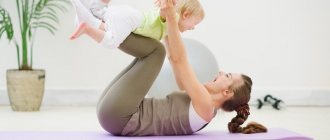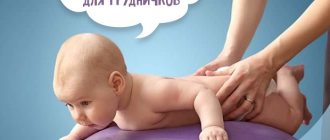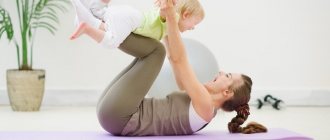The benefits of exercise therapy for the musculoskeletal system of children
The process of formation of the musculoskeletal corset of the spine is primarily determined by the state of the child’s entire muscular system, the task of which is to effectively maintain the spinal column in its natural position.
Systematic exercise therapy helps to harden the child’s body, developing its muscles, the strengthening of which will help keep the spine in a physiologically correct position.
The benefits of physical therapy for a child are as follows::
- general healing and general strengthening effect, normalization of the activity of all body systems, increased immunity, stabilization of the nervous system;
- activation of metabolic processes;
- improving motor skills and coordination, increasing overall physical endurance;
- strengthening the muscles of the back, abs, torso (muscle corset), muscles of the arms, legs and neck in general;
- eliminating the imbalance that occurs when the formation and stretching of ligaments and muscles is not sufficiently uniform;
- relieving increased load on the spinal column;
- correction of posture, prevention of curvatures (scoliosis, kyphosis, lordosis).
Exercise therapy is very important for children, as it strengthens the deep back muscles, and this prevents spinal curvature
Exercise therapy from a very early age will require patience and perseverance from parents, but its importance cannot be overestimated in relation to the prevention of back problems that inevitably appear in a child during school.
Main conclusions
It is possible to prevent poor posture, degenerative-dystrophic changes in the spine and other serious diseases at home by following these recommendations:
- Start doing back exercises from an early age to prevent poor posture.
- When the first symptoms of spinal curvature appear, consult a doctor who will draw up treatment tactics and an individual complex.
- When choosing a training program, consider the child’s age and make sure there are no contraindications.
- Make sure that children perform the exercises correctly, in full amplitude, at a smooth pace.
- If you experience severe back pain, stop exercising and consult a doctor.
- Buy an orthopedic mattress, a chair, and a backpack with a hard back to prevent poor posture.
- If a child's back gets tired, he should wear a special corset.
- Calcium-based vitamin preparations will help enhance the effect of exercise.
By following these rules, parents will be able to maintain the health of their child’s spine, make him strong and beautiful.
Indications for exercise therapy classes
If the habit of performing a set of special physical exercises to strengthen the back has not been instilled in the child since childhood, then during school years, due to a sharp increase in the load on the spine, with careful observation of the student’s behavior, parents may notice a number of signs indicating the need for prevention.
Signs of incipient problems with the development of the spine include:
- fast fatiguability;
- clumsiness and awkwardness of movements;
- child’s refusal to play outdoor games;
- complaints of headaches and soreness at the neck level;
- pain in the limbs that appears after walking;
- sitting pose with emphasis on hands;
- difficulties during a long stay in one position;
- characteristic crunching of joints heard during movements.
Parents who notice at least one or several of these symptoms should contact a specialist as soon as possible. Only a doctor can choose the right medications and prescribe the procedures necessary to correct emerging posture disorders. .
In addition, exercises to strengthen the spine are prescribed to children with the following indications::
- general developmental delay;
- scoliosis;
- rickets;
- hip dysplasia;
- displacement of vertebral discs;
- flat feet;
- clubfoot;
- curvature of the neck.
Learn more about back problems in children and their treatments:
- You can read about the prevention and treatment of scoliosis in children here
- Features of performing massage for scoliosis in children
- Exercises for scoliosis for children
- You can find out when and how hyperkyphosis forms in children on the page
Exercises to strengthen the back in children
Depending on the child’s age, his emotional state and other physiological indicators, the doctor determines the duration of physical therapy sessions aimed at strengthening the spinal column.
On average, the duration of exercise is determined as follows::
- infants up to six months will benefit from exercises performed from 10 to 20 minutes a day;
- Babies from 6 to 12 months will benefit from daily thirty-minute exercises;
- Children from one to three years old can exercise up to 30-40 minutes daily.
Infants need to be introduced to physical activity gradually, because their spinal column is not yet fully formed
It is best that the first lesson is conducted by a professional massage therapist who can show parents the correct technique.
Therapeutic and strengthening exercises for the back muscles should be carried out with a certain frequency. You should start exercising 3 times a week . If the child reacts positively to the loads, their frequency can be increased to daily training.
In terms of technique, it is important to remember that any workout should begin with a warm-up. It should be followed by a basic set of exercises, necessarily including light stretching. During training, you need to avoid the same type of exercises.
You should also exclude exercises that cause pain and discomfort in the child. Physical therapy exercises, like any other sport, are most beneficial when carried out 50-60 minutes before or after a meal.
During physical exercise for therapeutic purposes, a number of simple but mandatory rules :
- A set of special exercises should be developed by the attending physician strictly according to individual indicators based on preliminary diagnosis. The recommendations given by the specialist regarding the technique of performing the exercises must be strictly followed. During physical therapy exercises, carefully monitor the child’s posture; in this case, the position of the back should be as close as possible to the physiological position.
- Physical therapy classes should be conducted in an office with special equipment. This can be either a clinic or home setting. It is important that the child always performs exercises under adult supervision.
- At the beginning of regular physical therapy classes, the child, together with one or both parents, must undergo training in the appropriate clinic room.
- Each lesson should begin with a massage and warm-up.
- The entire exercise should be performed at a slow pace, excluding sudden movements, jumps or jerks. It is not permissible to include elements of acrobatics.
- An important rule is the contraindication of increased physical activity using weights, including barbells, weights, dumbbells, if there are existing postural disorders.
- During exercise, the sensation of any, even the slightest pain should be excluded.
- Special rotational exercises or stretching of the spinal column are also not recommended for training. Only passive stretching is permissible, in which there is always support under the feet.
- The increase in loads should occur slowly and gradually, from simple to complex elements, avoiding forcing.
- When compiling a set of exercises, it should be possible to alternate the load for different muscle groups and include breathing exercises after physical training.
Video: “How to strengthen a child’s back muscles on a gymnastic ball?”
Preparation and warming up
Did you know that...
Next fact
Beginning physical therapy exercises should include the following::
- stroking;
- rubbing;
- kneading muscles;
- vibrations.
In this case, special attention must be paid to preparing the child for the procedure.
The child’s health should be good, his mood should be normal and balanced, he should feel cheerful and rested. Before starting training, the room should be well ventilated. The most optimal temperature for exercise is 18-22 degrees.
Children usually benefit from warming up their muscles with a massage or taking a warm shower before starting exercise. Classes must be held regularly at the same hours. When conducting training, it is worth playing soft music, which will help the child relax and get ready for work.
The following are suitable warm-up exercises::
- inhaling air from the stomach through the mouth, followed by holding the breath for a few seconds and then exhaling through the nose;
- rotational movements of the shoulders together and alternately;
- tilting the head in different directions;
- swing your arms;
- tilting the body in different directions from the “hands in the lock” position;
- hip rotation;
- bend down, trying to touch your hands with the tip of your toes;
- walking in place with high knees;
- running in place;
- take a deep breath and exhale completely.
Basic exercises
Basic general strengthening exercises. Below are a few more exercises to strengthen your core muscles.
The main exercises of physical therapy usually include the following::
- A ride on the bicycle . From a supine position, your legs make circular movements in the air with imaginary pedals.
- Scissors . Swing with straight legs in a horizontal direction with crossing.
- Kolobok . Pulling your legs bent at the knees, clasping them with your arms and rolling on your back along a comfortable trajectory.
- Bridge over the road . This exercise is performed from a lying position on your back, with your legs bent at the knees, your feet resting on the floor, your arms remaining along your body. You need to lift your pelvis off the floor and try to bend, lifting it as high as possible. You should stay in this position for 5 seconds, then return to the starting position.
- Acrobat . Performed from a supine position, arms lying along the body. It is necessary to raise your legs straight, trying to touch the floor behind your head with your toes.
- Kitty . Bend your back down and up from a standing position on all fours.
- Basket of berries . Lying on his stomach, the child clasps his ankles with both hands and tries to pull himself up as high as possible to a position similar to a three-dimensional basket.
- Swimmer . From a lying position on your stomach, swings are made with straight arms and legs in the air, simulating the movements of a swimmer.
- Boat . Lying on his stomach, the child should try to lift his arms and legs off the floor and freeze in the air, remaining in this position for as long as possible.
Video: “Exercises to strengthen the back muscles”
Completion
Pay attention to the final stages of gymnastics. The final exercises of physical therapy must necessarily include actions that help restore breathing and pulse, and relax all muscles.
Various shaking, rotating and stroking movements, and patting may be recommended.
It is extremely undesirable to be distracted from training in its midst by moving on to everyday activities, due to the high risk of injury to heated muscles.
At the end of the workout, it is useful to slow down the pace, which will allow the body to feel the completion of the complex.
This will leave you with a feeling of strength and vigor.
It is also useful to move on to water procedures at the end.
Contraindications for exercise therapy in children
Performing physical therapy, like any other sports exercises, is highly not recommended if you are feeling unwell, complaining of fever, or if any pathology is acute..
Contraindications for exercise are also any heart rhythm disturbances or respiratory failure . Performing exercises is prohibited in case of existing malignant pathologies, acute forms of rickets and tuberculosis, hepatitis, inflammation in joints, bones and soft tissues.
If any of the listed ailments appears, training should be canceled until the child has fully recovered.
Contraindications
It is prohibited to perform gymnastics for the back if the child does not feel well, there is weakness, fever or any illness in the acute stage.
If the functionality of the cardiovascular or respiratory system is impaired, exercise should be abandoned.
The restriction applies to children with oncological pathologies, rickets, tuberculosis, hepatitis, and acute arthritis. Training is carried out only after complete recovery.
Important! When compiling a set of exercises, you need to take into account age characteristics. Children from 2 to 4 years old are active, but get tired quickly. A 6-7 year old child has rapid blood circulation, so the heart rhythm is often disturbed. Children 8-12 years old should study from 3 to 4 hours per day. Teenagers need intense, but short-term training.











